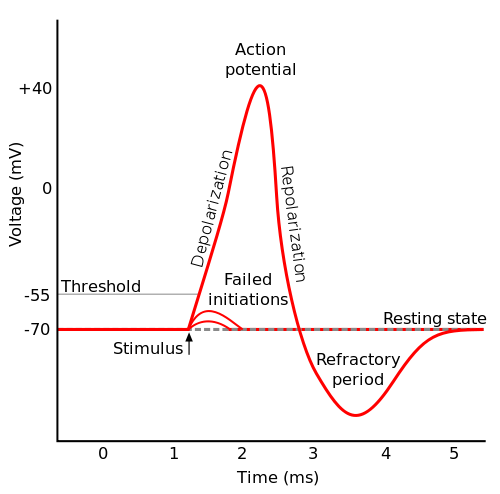
Physiology
Basic Cellular
Regarding the refractory period, which of the following statements is INCORRECT:
Answer:
Following the action potential, Na+ channels remain inactive for a time in a period known as the absolute refractory period where they cannot be opened by any amount of depolarisation. Following this there is a relative refractory period where the temporary hyperpolarisation (due to delayed closure of rectifier K+ channels) makes the cell more difficult to depolarise and an action potential can be generated only in response to a larger than normal stimulus. The refractory period limits the frequency at which action potentials can be generated, and ensures that, once initiated, an action potential can travel only in one direction. An action potential is an all or nothing response so the amplitude of the action potential cannot be smaller.Generation of Action Potentials
Physiology / Basic Cellular / Autonomic Nervous System
Last Updated: 26th July 2024
Once triggered an action potential will travel over the entire surface of an excitable cell and will always have the same amplitude. An action potential is an all or nothing response; because the size of the action potential is constant, the intensity of the stimulus is coded by the frequency of firing of a neuron.
Threshold Potential
Action potentials are initiated in nerves by activation of ligand-gated Na+ channels by neurotransmitters. Opening of these Na+ channels results in a small influx of sodium and depolarisation of the negative resting membrane potential (-70 mV).
If the stimulus is sufficiently strong, the resting membrane depolarises enough to reach threshold potential (generally around -55 mV), at which point an action potential can occur.
Depolarisation
Voltage-gated Na+ channels open, causing further depolarisation and activating more voltage-gated Na+ channels and there is a sudden and massive sodium influx, driving the cell membrane potential to about +40 mV.
Repolarisation
The spike of the action potential is transient because as the membrane potential becomes positive, the voltage-gated Na+ channels inactivate preventing further sodium influx.
Voltage-gated K+ channels are also activated, causing the K+ permeability to again be much greater than that for Na+, and the potassium efflux leads to repolarisation.
Delayed closure of these rectifier K+ channels causes a transient hyperpolarisation.
Refractory Period
Following the action potential, Na+ channels remain inactive for a time in a period known as the absolute refractory period where they cannot be opened by any amount of depolarisation.
Following this there is a relative refractory period where the temporary hyperpolarisation makes the cell more difficult to depolarise and an action potential can be generated only in response to a larger than normal stimulus.
The refractory period limits the frequency at which action potentials can be generated, and ensures that, once initiated, an action potential can travel only in one direction.

Action Potential. (Image by Unknown. [CC-BY-SA-3.0 , via Wikimedia Commons)
Report A Problem
Is there something wrong with this question? Let us know and we’ll fix it as soon as possible.
Loading Form...
- Biochemistry
- Blood Gases
- Haematology
| Biochemistry | Normal Value |
|---|---|
| Sodium | 135 – 145 mmol/l |
| Potassium | 3.0 – 4.5 mmol/l |
| Urea | 2.5 – 7.5 mmol/l |
| Glucose | 3.5 – 5.0 mmol/l |
| Creatinine | 35 – 135 μmol/l |
| Alanine Aminotransferase (ALT) | 5 – 35 U/l |
| Gamma-glutamyl Transferase (GGT) | < 65 U/l |
| Alkaline Phosphatase (ALP) | 30 – 135 U/l |
| Aspartate Aminotransferase (AST) | < 40 U/l |
| Total Protein | 60 – 80 g/l |
| Albumin | 35 – 50 g/l |
| Globulin | 2.4 – 3.5 g/dl |
| Amylase | < 70 U/l |
| Total Bilirubin | 3 – 17 μmol/l |
| Calcium | 2.1 – 2.5 mmol/l |
| Chloride | 95 – 105 mmol/l |
| Phosphate | 0.8 – 1.4 mmol/l |
| Haematology | Normal Value |
|---|---|
| Haemoglobin | 11.5 – 16.6 g/dl |
| White Blood Cells | 4.0 – 11.0 x 109/l |
| Platelets | 150 – 450 x 109/l |
| MCV | 80 – 96 fl |
| MCHC | 32 – 36 g/dl |
| Neutrophils | 2.0 – 7.5 x 109/l |
| Lymphocytes | 1.5 – 4.0 x 109/l |
| Monocytes | 0.3 – 1.0 x 109/l |
| Eosinophils | 0.1 – 0.5 x 109/l |
| Basophils | < 0.2 x 109/l |
| Reticulocytes | < 2% |
| Haematocrit | 0.35 – 0.49 |
| Red Cell Distribution Width | 11 – 15% |
| Blood Gases | Normal Value |
|---|---|
| pH | 7.35 – 7.45 |
| pO2 | 11 – 14 kPa |
| pCO2 | 4.5 – 6.0 kPa |
| Base Excess | -2 – +2 mmol/l |
| Bicarbonate | 24 – 30 mmol/l |
| Lactate | < 2 mmol/l |

